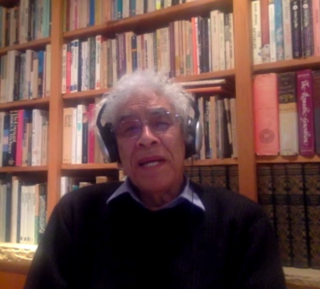
Numerical climate models are mathematical models that can simulate the interactions of important drivers of climate. These drivers are the atmosphere, oceans, land surface and ice. Scientists use climate models to study the dynamics of the climate system and to make projections of future climate and of climate change. Climate models can also be qualitative models and contain narratives, largely descriptive, of possible futures.

A general circulation model (GCM) is a type of climate model. It employs a mathematical model of the general circulation of a planetary atmosphere or ocean. It uses the Navier–Stokes equations on a rotating sphere with thermodynamic terms for various energy sources. These equations are the basis for computer programs used to simulate the Earth's atmosphere or oceans. Atmospheric and oceanic GCMs are key components along with sea ice and land-surface components.
The Carl-Gustaf Rossby Research Medal is the highest award for atmospheric science of the American Meteorological Society. It is presented to individual scientists, who receive a medal. Named in honor of meteorology and oceanography pioneer Carl-Gustaf Rossby, who was also its second (1953) recipient.

Jule Gregory Charney was an American meteorologist who played an important role in developing numerical weather prediction and increasing understanding of the general circulation of the atmosphere by devising a series of increasingly sophisticated mathematical models of the atmosphere. His work was the driving force behind many national and international weather initiatives and programs.

Numerical weather prediction (NWP) uses mathematical models of the atmosphere and oceans to predict the weather based on current weather conditions. Though first attempted in the 1920s, it was not until the advent of computer simulation in the 1950s that numerical weather predictions produced realistic results. A number of global and regional forecast models are run in different countries worldwide, using current weather observations relayed from radiosondes, weather satellites and other observing systems as inputs.
This is a list of meteorology topics. The terms relate to meteorology, the interdisciplinary scientific study of the atmosphere that focuses on weather processes and forecasting.

Oceanic and Atmospheric Research (OAR) is a division of the National Oceanic and Atmospheric Administration (NOAA). OAR is also referred to as NOAA Research.
The Modular Ocean Model (MOM) is a three-dimensional ocean circulation model designed primarily for studying the ocean climate system. The model is developed and supported primarily by researchers at the National Oceanic and Atmospheric Administration's Geophysical Fluid Dynamics Laboratory (NOAA/GFDL) in Princeton, NJ, USA.

Joseph Smagorinsky was an American meteorologist and the first director of the National Oceanic and Atmospheric Administration (NOAA)'s Geophysical Fluid Dynamics Laboratory (GFDL).

Syukuro "Suki" Manabe is a Japanese–American physicist, meteorologist, and climatologist, who pioneered the use of computers to simulate global climate change and natural climate variations. He was awarded the 2021 Nobel Prize in Physics jointly with Klaus Hasselmann and Giorgio Parisi, for his contributions to the physical modeling of Earth's climate, quantifying its variability, and predictions of climate change.
Geophysical Fluid Dynamics Laboratory Coupled Model is a coupled atmosphere–ocean general circulation model (AOGCM) developed at the NOAA Geophysical Fluid Dynamics Laboratory in the United States. It is one of the leading climate models used in the Fourth Assessment Report of the IPCC, along with models developed at the Max Planck Institute for Climate Research, the Hadley Centre and the National Center for Atmospheric Research.

Thomas R. Knutson is a climate modeller at the US Geophysical Fluid Dynamics Laboratory, a division of the National Oceanic and Atmospheric Administration (NOAA). His research covers hurricane activity, the link between climate change and hurricane incidence and intensity, and climate change detection and attribution.
Kirk Bryan Jr. is an American oceanographer who is considered to be the founder of numerical ocean modeling. He is the son of Kirk Bryan, Sr.. Starting in the 1960s at the Geophysical Fluid Dynamics Laboratory, then located in Washington, D.C., Bryan worked with a series of colleagues to develop numerical schemes for solving the equations of motion describing flow on a sphere. His work on these schemes led to the so-called "Bryan-Cox code" with which many early simulations were made, and which led to the Modular Ocean Model currently used by many numerical oceanographers and climate scientists.
A chemical transport model (CTM) is a type of computer numerical model which typically simulates atmospheric chemistry and may give air pollution forecasting.

Isaac Meyer Held is an American meteorologist. He is a retired senior research scientist at the Geophysical Fluid Dynamics Laboratory. Held was elected to the United States National Academy of Sciences in 2003.
The NOAA National Operational Model Archive and Distribution System (NOMADS) is a Web-services based project providing both real-time and retrospective format independent access to climate and weather model data.
Shian-Jiann Lin is a Taiwanese-American atmospheric scientist and meteorologist. He is currently the head of the Weather and Climate Dynamics Division at the Geophysical Fluid Dynamics Laboratory, the lead developer of the GFDL Finite-Volume Cubed-Sphere Dynamical Core (FV3). and a lead developer or key contributor to several weather and climate models developed using FV3.

Samuel George Harker Philander is a climate scientist, known for his work on atmospheric circulation and oceanic currents, particularly El Niño. He is the Knox Taylor Professor emeritus of Geosciences at Princeton University.

Thomas L. Delworth is an atmospheric and oceanic climate scientist and Senior Scientist at the Geophysical Fluid Dynamics Laboratory (GFDL), part of NOAA. He also serves on the faculty of Oceanic Science at Princeton University.

Ronald J. Stouffer is a meteorologist and adjunct professor at the University of Arizona, formerly Senior Research Climatologist and head of the Climate and Ecosystems Group at the Geophysical Fluid Dynamics Laboratory (GFDL), part of NOAA. He has also served on the faculty of Princeton University.











